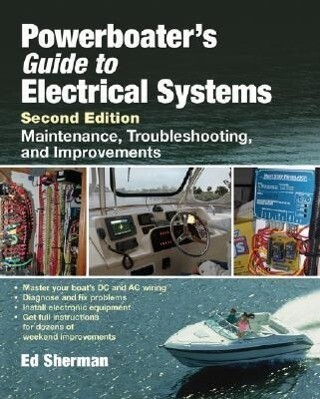
Zustellung: Sa, 19.07. - Do, 24.07.
Versand in 2 Wochen
VersandkostenfreiUnderstand, troubleshoot, repair, and upgrade your boat's electrical systemsFrustrated by the high cost of basic electrical work but nervous about tackling such projects yourself? Get sound advice and guidance from author Ed Sherman, who wrote and teaches the American Boat & Yacht Council's certification program for electrical technicians. In Powerboater's Guide to Electrical Systems, he combines basic theory with step-by-step directions for troubleshooting problems, making repairs, and installing new equipment. Learn to
- Draw up a wiring diagram for your boat
- Locate and identify wiring and circuit components
- Select and use a multimeter
- Choose and maintain battery and marine ignition systems
- Troubleshoot starting, charging, and instrument problems
- Install DC and AC marine accessories, equipment, and electronics
Inhaltsverzeichnis
Foreword to the Second Edition by Skip Burdon, President and CEO, American Boat & Yacht CouncilPreface to the Second EditionIntroductionChapter 1. Electrical Basics You Need to KnowWhat Is Electricity? Electrical CircuitsOhm's Law and What It Can Tell UsVoltage DropPutting It All TogetherCircuit Problems and How They OccurToolsChapter 2. Working with Wiring DiagramsThe Trouble with BoatsWiring DiagramsCommon SymbolsComponent IdentificationWire Identification and the ABYC Color CodeExpanding the Basic CircuitLocating ComponentsDrawing Your Own Wiring DiagramChapter 3. Selecting and Using a MultimeterMultimetersSelecting a MultimeterUsing Your MultimeterMeasuring AmperageMeasuring Resistance and ContinuityChapter 4. Wire and Circuit Protection Standards and Repair ProceduresOrder Out of ChaosABYC Standards and RecommendationsBasic WiringWire SizeWire InsulationFuses and Circuit BreakersIgnition ProtectionTesting Fuses and Circuit BreakersLevels of Circuit ProtectionAcceptable Locations for Fuses and Circuit BreakersWire Routing and SupportConnecting the Dots: Making Wiring and Connection RepairsChapter 5. Batteries and Battery SystemsHow Batteries Work: The BasicsBasic ChemistryTypes of Lead-Acid BatteriesWhich Battery Is Right for You? Battery SafetyBattery Maintenance and TestingBattery InstallationsTesting Your BatteriesChapter 6. Battery-Charging SystemsAlternator BasicsEngine-Driven Marine AlternatorsAlternator ProblemsOutboard-Engine Charging SystemsShore-Power Battery Charging Systems and InstallationsSolar CellsChapter 7. Maintaining Marine Ignition SystemsIgnition-System ComponentsRegulations Regarding Ignition SystemsOutboard and PWC Ignition SystemsMaintaining Ignition SystemsMerCruiser Thunderbolt IV and Thunderbolt V SystemsBeyond the Basics: Outboard and PWC Ignition SystemsOutboard and PWC Ignition TestsTesting Your Stop SwitchFinal Checks and Ignition TimingChapter 8. Tracing and Repairing Starter-Motor CircuitsCoast Guard Regulations for Starter MotorsStarter-Motor Problems and SolutionsTroubleshooting Starter-Motor CircuitsOutboard-Engine Starter CircuitsTesting the Neutral-Safety SwitchEngine Ignition SwitchOther Outboard-Engine Starter-Motor ProblemsChapter 9. Installing Your Own DC AccessoriesBefore You BeginInstalling a New Cabin LightInstalling a New Bilge PumpAdding a New Compact-Disc PlayerChapter 10. Engine Instrumentation Problems and SolutionsMechanical GaugesCommon Instrument Interpretation ProblemsAbnormal Instrument ReadingsGeneral Instrument TroubleshootingThe FutureChapter 11. Alternating Current and AC EquipmentWhat Is Alternating Current? AC on Your BoatAC SafetyColor Coding for AC WiringComparisons between AC and DC CircuitsAC Overcurrent ProtectionBasic AC Outlet ConnectionsGround-Fault Circuit InterruptersChecking Voltage, Continuity, and Polarity on AC CircuitsSelecting a DC-to-AC InverterAC GeneratorsGalvanic Isolators< h3> Chapter 12. Installing
Produktdetails
Erscheinungsdatum
13. August 2007
Sprache
englisch
Auflage
2nd edition
Seitenanzahl
228
Autor/Autorin
Edwin R Sherman
Verlag/Hersteller
Produktart
gebunden
Gewicht
617 g
Größe (L/B/H)
233/192/16 mm
ISBN
9780071485500
Bewertungen
0 Bewertungen
Es wurden noch keine Bewertungen abgegeben. Schreiben Sie die erste Bewertung zu "Powerboater's Guide to Electrical Systems" und helfen Sie damit anderen bei der Kaufentscheidung.







